Time Line of Aviation
Compiled by the
Otto-Lilienthal-Museum Anklam
 About 2300
BC
About 2300
BC- Relief of King Etana riding an eagle in the ruins of
Ninive (on exhibit in the Museum).
- About 750 BC
- Emergence of the legend of Daedalus and Icarus.
- About 400 BC
- The often described pigeon of the Greek mathematician
Archytas of Tarant could have been a kite.
- 220 BC
- Records indicate the Chinese used kites as
rangefinders.
- 200 BC
- Emergence
of the legend of Alexander, in which Alexander of Macedonia flew in the
company of some half-starved griffins to the end of the world. This
theme turns up frequently (on exhibit in the Museum).
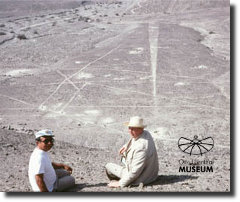 2nd
Century BC - 5th Century AD
2nd
Century BC - 5th Century AD- Large geoglyphs from the Nazca culture ("earth
drawings" up to several
kms in length) are preserved in the high desert of Peru. A new hypothesis suggests they are
prehistoric take-off and landing sites for kites or hang gliders.
- 10th Century AD
- The glider-kite is presumed to have gained usage
around the Pacific. It was probably manned and used for military,
religious and ceremonial reasons.
- 1247 AD
- The Mongolian army used lighted kites in the battle
at Liegnitz.
- 1282 AD
- Marco Polo reports manned and ritual kite ascents.
- 1316 - 1390 AD
- Albert of Saxony, Bishop of Halberstadt, holds the
opinion that air could carry a reasonably constructed machine as water
can carry a ship (Archimedes principle).
- 1486 - 1513 AD
- Technical
and mathematical flight studies of Leonardo da Vinci (1452 - 1519 AD).
Designs for a parachute, helicopter, and ornithopter were found in his
notes, as well as studies of airflows and streamlined shapes. Obviously
Leonardo was the first to understand the mechanics of the bird flight.
- 1496 AD
- The Italian Mathematician Giambattista Danti is
supposed to have flown from a tower. There are many reports of supposed
flights and attempts to fly in many countries. In the Middle Ages the
ability to fly was attributed by popular belief to saints and witches.
- About 1500 AD
- Hieronymus Bosch shows in his triptych "The
Temptation of the Saint Anthony" two fighting airships above a burning
town, among other flight scenes.
- 1558 AD
- Giambattista della Porta publishes a theory and a
construction manual for a kite.
- 1644 AD
- The Italian physicist Evangelista Toricelli manages
to give proof of atmospheric pressure. He also produces a vacuum.
- 1654 AD
- The physicist and mayor of Magdeburg, Otto von
Guericke, measures the weight of air and demonstrates his famous
"Magdeburger Halbkugeln" (hemispheres of Magdeburg): 16 horses are
unable to pull apart two completely airless hemispheres that stick to
each other only because of the external air pressure.
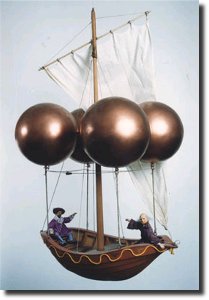 1670
AD
1670
AD - The Jesuit Francesco Lana de Terzi describes in his
treatise "Prodomo" a vacuum-airship-project.
This is considered to be the first realistic, technical plan for an
airship. (on exhibit in the Museum). Lana writes: "God will
never allow that such a machine be built…because everybody realises
that no city would be safe from raids…"
- 1678 AD
- Reported flight of the French locksmith Besnier with
a flapping wing machine (on exhibit in the museum).
- 1680 AD
- The Italian physicist Alphonso Borelli shows in his
treatise "movements of animals" that the flapping of wings with the
muscle power of the human arm cannot be successful.
- 1687 AD
- Isaac Newton (1642 - 1727) published the "Philosophiae
naturalis principia mathematica", the basics of classical
physics. In book II he published the theoretical derivation of the
basic drag equation.
- 17th Century AD
- The kite is popular during the century.
- 1709 AD
- Airship-privilege and Montgolfière experiments by
Lourenco de Gusmao in Lisbon (on exhibit
in the Museum).
- 1716 AD
- Well thought-out glider-project of the Swedish
scholar Emanuel Swedenborg. The bases for his construction are bird
flight and the glider kite.
- 1738 AD
- In his "Hydrodynamica" the Swiss scholar Daniel Bernoulli (1700 - 1782) formulates the
principle of the conservation of energy for gases (Bernoulli's Law),
the relationship between pressure and velocity in fluid flow.
- 1746
- The English military engineer Benjamin Robins (1707 -
1751) invented among others a whirling arm apparatus in order to
determine drag.
- 1766
- The British chemist Henry Cavendish determines the
specific weight of hydrogen gas.
- 1772
- Abbé Desforges tries out unsuccessfully, a flying
apparatus with a basket and oars made of bird feathers.
- 1777
- In
St. Louis the prisoner Dominikus Dufort jumps with a parachute garment
off a high building and is rewarded with a spontaneous collection of
money.
- 1781
- The Italian scientist Tiberiua Cavallo, living in
England, sends up soap bubbles filled with oxygen.
- 1783
- Sebastian Lenormand does several parachute jumps from
the tower of the observatory in Montpellier.
- June 5, 1783
- Rise of an unmanned, hot-air-balloon (Montgolfière)
of the brothers Montgolfier in Vivarais, France.
- August 27, 1783
- Rise of an unmanned, experimental hydrogen-balloon in
Paris (built by Prof. Charles and the Robert brothers).
- September 19, 1783
- A duck, a cock, and a sheep were the first living
creatures to fly in a Montgolfière in Versailles.
- October 15, 1783
- Pilatre de Rozier and Marquis d'Arlandes ascend with
a Montgolfière that is tied to the ground in Paris.
- November 21, 1783
- J. P. Pilatre de Rozier and Marquis d'Arlandes make
the first free flight of nine kilometers in the untethered Montgolfière
in Paris.
- December 1, 1783
- Prof. Charles and his assistant Robert fly the first
hydrogen-filled balloon (Charliere). On his second flight, Prof.
Charles reaches an altitude of 2,700 m in Vivarais.
- 1784
- Pilâtre de Rozier and the chemist Proust rise in a
Montgolfière to 4,000 m.
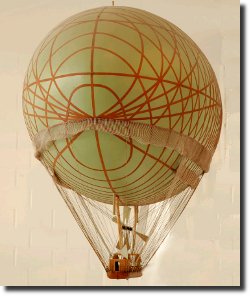 1784
1784- Airship project of Jean Baptiste Meusnier to explore
unknown areas with an oblong balloon, Ballonet with an airscrew powered
with muscle power (on exhibit in the Museum).
- September 19, 1784
- The brothers Robert and Colin Hullin ride in a
balloon over 186 km from Paris to Beuvry.
- January 7, 1785
- Jean-Pierre Blanchard and the American meteorologist
John Jeffries cross the English Channel from Dover to Guines in a hot
air balloon.
- June 15, 1785
- Pilâtre de Rozier and Piére Romain crash with their
balloon as they begin crossing the English Channel and become the first
casualties in the history of aviation. History records Pilâtre de
Rozier as the first human to fly and the first to die in an aviation
accident.
- January 9, 1793
- Blanchard made the first balloon ascent in North
America, launching from the Washington Prison Yard in Philadelphia,
Pennsylvania, and landing in Gloucester County, New Jersey, while
carrying the first airmail letter. The flight was observed by President
George Washington.
- 1793
- Military use of a captive balloon at the siege of
Mainz.
- April 2, 1794
- Establishment of the first airship company in the
French army.
- October 22, 1797
- André-Jaques Garnerin jumps from a balloon with a
parachute and becomes "official French aeronaut of the state".
- 1799
- The Englishman Sir George Cayley (1773 - 1857)
sketched a glider with a rudder unit and an elevator unit (presented in
the exhibition). His manuscript is considered to be the starting point
of the scientific research on flying "heavier than air flying
machines." It was Cayley who helped to sort out the confusion of that
time. …"He knew more than any of his predecessors … and successors up
to the end of the 19th century." - Orville Wright. Even so, his ideas
did not affect further development.
- Around 1800
- Francisco Goya shows in his etching "The Art of
Flying," people with man-made wings, which are to be moved by the arms
and legs. The flyers are shown in great detail from different views.
- July 18, 1803
- Etienne Gaspar Robertson and Lhoest ascent from
Hamburg to 7,280 m.
- October 3-4, 1803
- The Frenchman André-Jaques Garnerin covered a
distance of 395 km from Paris to Clausen with his Montgolfière.
- August/September 1804
- The Physicists Joseph-Lois Gay-Lussac and Jean
Baptiste Biot started with scientific measurements and disproved the
thesis that the earth's pull decreases with height.
- 1804
- J. Kaiserer made the suggestion of making a
Montgolfière maneuverable with the help of tamed eagles.
- 1804
- Sir
George Cayley successfully tested a hand-lunched glider with moveable
control surfaces similar to a modern-configuration airplane (presented
in the exhibition).
- 1807
- Jakob Degen, a watchmaker from Vienna, did
experiments with a device with valve flap flapping wings (presented in
the exhibition).
- 1808
- J. Degen tries to combine a Montgolfière with the
flapping wings.
- September 1809
- Sir
George Cayley published his seminal paper "On Aerial Navigation,"
publishing for the first time the scientific principles of
heavier-than-air flight.
- May 31, 1811
- Albrecht Ludwig Berblinger, the "tailor of Ulm"
crashes with his flying machine that is a copy of J. Degen's into the
Danube. It was presumably a workable hang glider. (presented in the
exhibition)
- July 19, 1812
- Usage of lamp gas for the filling of a Montgolfière
(Charles Green).
- 7th and 8th of November in 1836
- Flight with a coal gas Montgolfière by Charles Green
covering a distance of 722 km from London to Weilburg with passengers
Holland and Mason.
- 1838
- The American John Wise introduces the ripping panel,
which is still used today. The ripping panel is the solution to the
problem when the Montgolfière were dragged along the ground by the wind
when landing and had to be stopped with the help of anchors.
- 1839
- Charles Green and the astronomer Spencer Rush rise to
7,900 m in a free balloon.
- November 1842
- The English engineer William Samuel Henson makes the
first complete drawing of a power driven aeroplane with steam engine
drive. The patent follows the works of Cayley. The English House of
Commons rejects the motion for the formation of an "Aerial Transport
Company" with great laughter (presented in the exhibition).
- 12th and 25th of July in 1849
- Austrian Montgolfières used for the first time to
bomb a city, Venice.
- October 7, 1849
- The Frenchman Francisque Arban flew over the Alps in
a free balloon (Marseille-Subini near Turin).
- 1849
- Sir
George Cayley builds the first man-carrying triplane, which was towed
like a kite down a slope. Another successful monoplane flight occurs in
1853 with Cayley's coachman as the pilot.
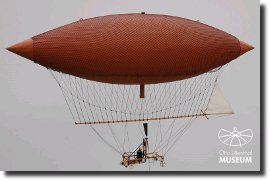 September
24, 1852
September
24, 1852- The
airship powered with a steam engine of the English engineer Henry
Giffard reaches a speed of approximately 10 km/h (presented in the
exhibition).
- 1852
- Formation of the first society for promoting aerial
navigation (Societe Aerostatique de France).
- 1857
- The French brothers du Temple de la Croix apply for a
patent for a power-driven aeroplane after successful attempts with
models.
- 1857
- The
French Captain Jean Marie Le Bries makes attempts to fly after studying
albatross flight. It is said that his attempts were successful. A
photograph is evidence of his flying apparatus.
- 1858
- The French airman Nadar takes the first aerial
photographs.
- July 1-2, 1859
- John Wise and 3 companions complete a Montgolfière
flight over a distance of 1,292 km (St. Louis, Missouri - Henderson,
New York - USA).
- September 5, 1862
- The aeronaut Coxwell and the English physicist
Glaisher reach, after a dramatic take-off, a height of 9,000 m.
- 1865
- Jules Verne describes in his novel "The Journey to
the Moon" the launch of a rocket from Cape Canaveral, where many years
later, U. S. space flights actually start.
- 1865
- The Frenchman d'Esterno writes in his book "About the
flight of birds": "Gliding seems to be characteristic for heavy birds;
there are no odds that humans can not do the same with a fair wind."
- 1865
- The French Artist and farmer Louise Pierre Mouillard
makes a successful attempt to fly. After years of studies about bird
flight he publishes his book "L'Empire de l'Air" in 1881. He thinks
that imitation of gliding and sailing flight of birds is possible, but
not the imitation of the flapping of wings.
- 1867
- Henry Giffard installs a huge captive balloon for 20
passengers at the World Exposition in Paris.
- 1868
- M.Boulton applies for an English patent for the use
of a wing aileron.
- 1868
- First exhibition of aviation in London's Crystal
Palace.
- 1870/71
- Franco-Prussian War: In besieged Paris, 66
Montgolfières are built in order to pass over the ring of besieging
forces.
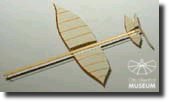 1871
1871 - The Frenchman Alphonse Pénaud builds a free-flying
flight model with rubber motor drive (presented in the exhibition).
- 1871
- The Englishmen Wenham and Browning do air flow
experiments in a wind tunnel.
- February 2, 1872
- The French Navy-engineer Dupuy de Lome reaches a
speed of 9 to 11 km/h with his muscle powered airship. (presented in
the exhibition)
- December 13, 1872
- The German engineer Paul Haenlein tests the first
airship with a gas engine in Brünn. The airship can reach a speed of 19
km/h. The tests were stopped because of a shortage of funds.
- July 5, 1874
- The Belgian Vincent de Groof is killed in an accident
as he tries to fly with flapping wings.
- 1874
- Otto and Gustav Lilienthal do lift-
and drag measurements of wing airfoils. The results were
published in 1889. Their research included the advantages of the curved
surface.
- 1875
- The Englishman Thomas Moy tests a tied down, power
driven aeroplane with steam engine drive and a wing span of 4 m.
- April 15, 1875
- The scientific flight of the Montgolfière "Zenith" to
8,000 m ends in the death of two aeronauts and the deafness of Gaston
Tissandier.
- 1876
- The Frenchmen Penaud and Gauchot apply for a patent
for a power-driven aeroplane with a device for drawing in the
undercarriage, with wings with upward dihedral and a stick control.
- 1877
- First flight of a steam-driven helicopter model
(Forlanini).
- 1879
- The Frenchman Victor
Tatin builds a power-driven aeroplane model with two
propellers and a compressed air motor. The model made successful starts
off the ground.
- 1881
- The Russian Alexander Fjodorowitsch Moshaiski gets
the patent for a power driven aeroplane with a steam engine.
- 1882
- The Berlin-based "German Society for Promoting
Aviation" first publishes a magazine, the "Zeitschrift für
Luftschiffahrt" (Magazine of Aviation).
- 1883
- The German Gottlieb Daimler invents the high speed
internal combustion engine, which is suitable for aviation because of
its good proportion between power and weight.
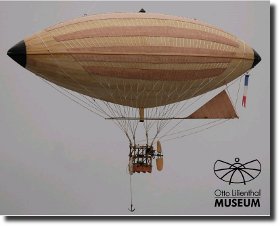 1883/84
1883/84 - Airships with electric engines (Tissandier brothers,
Renard and Krebs). The airship of Renard and Krebs flew for the first
time in a full circle and landed on the starting point on August 9th
(presented in the exhibition).
- 1884
- The Englishman Horatio F. Philipps receives a patent
for curved profiles of wings.
- September 12 -13, 1886
- The Frenchmen Hervé and Alluard make a Montgolfière
flight of over 24 hours.
- 1889
- Otto Lilienthal publishes in his book
"Der Vogelflug als Grundlage der Fliegekunst" (Bird Flight as the Basis
of Aviation),
measurements of wings, with so called polar diagrams, which are our
concept of description of airfoils even today. The book gives test
results showing the advantages of a cambered wing. (reprint available)
- October 9, 1890
- The Frenchman Ader's aeroplane "Eole" takes off.
- 1891
- Otto Lilienthal
flew over 25 meters. These flights are considered to be the
first safe, repeatable glides in history and his method "from jump to
flight" is considered as the only possibility for learning flying.
- 1893
- The Australian Hargrave demonstrates a box kite at an
aeronautical congress in Sydney (presented in the exhibition). It
becomes an example for several scientific kites and aeroplane
constructions.
- 1893
- First
experiments of the Englishman Philipps with a 50-wing-plane. Later, a
larger version of four banks of slats failed to get off the ground.
- December 4, 1894
- The German meteorologist Berson climbs to 9,155 m.
- 1894
- The large aeroplane of the American H. S. Maxim is
damaged in taxi tests, which showed the possibility to achieve
take-off. After that he stopped his experiments, which had already cost
him hundreds of thousands of dollars.
- 1894
- Otto Lilienthal goes with his "Normal-apparatus" in the first serial production of an aircraft. With different glider
designs, he covers distances up to 250 meters.
- 1894
- Octave Chanute's book "Progress in Flying Machines,"
which is a summary of many articles published in the "American Engineer
and Railroad Journal," is a comprehensive account on the stage of
aviation development worldwide. (Reprint
available)
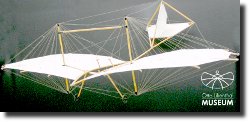 1895
to 1899
1895
to 1899- The English engineer Percy Sinclair Pilcher works
successfully on gliding and power flight (Exhibition area I). He was
killed in an accident on the 30th of September in 1899 at a gliding
performance.
- May 6, 1896
- The American Prof. Samuel Pierpont Langley does the
first flight with a steam engine aeroplane model over 1 km distance.
- August 9, 1896
- Otto Lilienthal crashes during a routine flight in
the hills of Stölln and dies next day because of a spinal injury.
- June 1896
- The railway engineer Octave Chanute organises a flyer
camp at Lake Michigan. A replica of a Lilienthal-glider and a biplane
built by Chanute were tested, and this was the basis for the further
development of flight technique (on exhibit in the Museum).
- 1896
- The Germans August von Parseval and Bartsch von
Sigsfeld invent the kite balloon useable during strong wind for
reconnaissance.
- June 11, 1897
- S. A. Andrée, N. Strindberg and K. Fraenkel start at
Spitzbergen with a free balloon for their North Pole expedition. They
were found dead in 1930. It was possible to develop their exposed film.
- June 12, 1897
- Friedrich Hermann Wölfert and his mechanic are killed
in an accident when their airship powered by petrol caught on fire at a
demonstration at the Tempelhof field.
- November 3, 1897
- Flight of an Aluminium-Airship designed by Hungarian
David Schwarz in Berlin.
- From 1900 to December 17, 1903
- Gliding, wind tunnel, control, and light-weight
engine design experiments of the Wright brothers (USA), lead to the
first successful powered flight of a controllable, heavier-than-air
aircraft.
- July 2, 1900
- First flight of metal airship of Ferdinand, Earl of
Zeppelin.
- July 31, 1901
- The German meteorologists Berson and Süring reach
10,800 m with a free balloon.
- August 14, 1901
- The German-American Gustav Weißkopf is reported to
have made the first stable engine flight over a distance of half a mile
in Bridgeport, Connecticut. The flight is disputed in the history of
aviation and did not have an effect on the development of flight.
- October 19, 1901
- The Brazilian Alberto Santos-Dumont starts with his
airship "Nr. 6" from St. Cloud, flew around the Eiffel Tower and comes
back to his starting point within 30 minutes. These were the conditions
for winning the Deutsch-Award, which included a prize of 100,000 Francs.
- 1901
- The seaplane of the Austrian W. Kress is destroyed
during take-off.
- 1901
- First flights of a power-driven aeroplane model with
a petrol engine (Prof. Langley, USA).
- 1901
- The Wright Brothers optimise their wings with the
help of wind tunnel measurements.
- 1903
- The Russian Konstantin Ziolkowski deduces the Basic
Rocket Equation in his article "Explorations of the outer space with
the help of reaction engines".
- August 18, 1903
- Karl Jatho does short air jumps with a power-driven
aeroplane near Hannover.
- October 8 and December 8, 1903
- Prof. Samuel Pierpont Langley's power-driven
aeroplane crashes at both attempts to fly after launching from a
catapult off a boat in the Potomac River at Washington, DC.
- December 17, 1903
- The four successful flights by the Wright Brothers in
the sand dunes near Kitty Hawk (North Carolina) are today considered
the beginning of powered flight. The fourth and longest flight lasted
59 seconds. While preparing for another flight, a wind gust turned the
plane over and damaged it. This "Flyer I" never flew again. (model on
exhibit in the Museum).
- September 20, 1904
- Wilbur Wright flew in a circle for the first time. In
order to make the take-offs easier, the Wrights developed a catapult.
- October 14, 1905
- Foundation of the Fédération Aéronautique
Internationale (FAI), which is still active in Paris today.
- October 4, 1905
- Orville Wright few for 33 minutes and 17 seconds in
Dayton, Ohio (USA).
- 1905
- In Santa Clara (California) Daniel Maloney flew for
20 minutes with a glider after he started from a Montgolfière at 1,220
meters height. He crashed during one of the following launchings.
- 1905
- The engineer Léger's helicopter lifts a person
vertically into the air in Monaco.
- November 12, 1906
- Santos-Dumont, who already caused a stir with his
one-man-airship in 1901, flew his unusual aircraft over a distance of
220 meters in Paris. His aeroplane combined the Wright's tail-first
machine with Hargrave's box kite.
- 1906
- "Swabia-drive" of the Zeppelin-airship LZ III. The
airship flew 350 km in eight hours.
- 1906
- First Gordon-Bennett free balloon race. Initially the
race was open for all aircraft. But only the balloons managed to cover
great distances.
- August 5, 1908
- The Zeppelin-airship LZ IV burned in Echterdingen.
- September 9, 1908
- Orville Wright flew 1 hour 3 minutes and 15 seconds.
- October 30, 1908
- Henry Farman made the first cross-country flight with
a power-driven aeroplane from Bouy to Reims (27 km in 20 minutes).
- December 18, 1908
- Wilbur Wright ascended to 115 meters in Auvours.
- December 31, 1908
- Wilbur Wright flew 2 hours and 20 minutes in Auvours.
-
- July 25, 1909
- The Frenchman L. Blériot crossed the English Channel
with his successful power-driven aeroplane "Blériot XI" from Calais to
Dover.
- July - October 1909
- International Exhibition of Aviation in
Frankfurt/Main (ILA - in every second year in Berlin nowadays).
- October 30, 1909
- Hans Grade won the "Lanz-Preis der Lüfte" (Lanz-Award
of Winds) - 40,000 RM for 2 km flown by a German pilot in a
German aeroplane.
- November 16, 1909
- Foundation of the first Air Transport Company in the
world, the DELAG (German Aviation Company).
- 1909
- First flight-weeks in Berlin-Johannisthal and
Frankfurt/Main.
- January 7, 1910
- The Frenchman Hubert Latham is the first pilot to
reach 1,000 meters.
- March 28, 1910
- Henry Fabre flew the first successful seaplane.
- 1910
- First night flights.
- 1910
- Races between aeroplanes and cars are only won by
racing cars.
- April 14, 1910
- Louis Paulhan flew 146 km in a straight route from
Orleans to Trois.
- July 9, 1910
- The Frenchman Léon Morane sets a new speed record of
106 km/h.
- September 23, 1910
- The Peruvian Geo Chavez flew with the
Blériot-monoplane over the Alps from Brig (Switzerland) to Domodossola
(Italy) at a height of 2,200 meters. He dies in the failed landing.
- 1910
- Hugo Junkers received a patent for his thick
wing/all-wing type aeroplane.
- 1911
- Claude Dornier built the first metal aircraft.
- April 12, 1911
- Pierre Prier flew non-stop from London to Paris in
less than 4 hours.
- October 24, 1911
- Orville Wright sails with a glider 9 minutes and 45
seconds in the dunes near Kitty Hawk (North Carolina).
- March 1, 1912
- Albert Berry does the first parachute jump out of an
aeroplane in St. Louis (USA).
- April 24, 1913
- O. Gilbert flew over a distance of 825 km from
Villacoublay to Vitoria (8 hours and 23 minutes).
- September 1, 1913
- The Frenchman Adolphe Pégoud does the first
upside-down flight.
- September 9, 1913
- Prevost reaches a speed of 204 km/h with the
"Deperdussin-racing aeroplane".
- December 11, 1913
- First flight of the Russian large aeroplane "Ilja
Murometz" (4 engines, 4.5 t lift off mass, 2 crew members, 10
passengers).
- December 13-17, 1913
- The German balloonist Hugo Kaulen stays in the air
with his free balloon for 87 hours. This record lasted until 1935.
- February 8-10, 1914
- Berliner, Haase and Nikolai fly 3,053 km with their
free balloon from Bitterfeld to Perm. This record lasted until 1950.
- July 10-11, 1914
- The German Reinhold Böhm flew with his
Albatross-biplane 24 hours and 12 minutes without refueling and without
a stopover. This one-man-flight record lasted until 1927.
- 1914 to 1918
- First World War: Aviation changes the theater of war
in a twofold way:
- The very young invention "Aeroplane" turns the sky into a new
battlefield. About 20,000 flyers, most of the trained pilots, die.
- Airships raise the clear distinction between frontline and
hinterland. The civilian population far behind the frontline becomes
the new target.
- November 21-24, 1917
- Journey through Africa with the Zeppelin-airship L
59. 6,757 km are flown in 96 hours (average speed 71km/h).
- June 14, 1919
- The
Englishman J. Alcock and A. W. Brown cross the Atlantic with the bomber
"Vickers EB.27 Vimy" - 8 years prior to the famous flight of Lindbergh.
Comment of Alcock: "Yesterday I was in America, and I am the first man
in Europe to say that."
- July 2-6 and 10-13, 1919
- The English airship "R 34" crosses the Atlantic Ocean
(England - USA - England).
- August 1, 1919
- A
kite reaches a height of 9,750 m in the meteorological observatory at
Lindenberg (near Berlin). This world height record is valid till this
day.
- August 24, 1919
- Opening of air traffic between Friedrichshafen and
Berlin (Airship "Bodensee").
- 1919
- The US-American R. H. Goddard publishes his essay "A
method for Reaching Great Height" a standard work of space flight
literature.
- 1919
- On the basis of the Peace Treaty of Versailles a
grounding order and a prohibition for building aeroplanes is issued in
Germany. These are modified several times in the following years.
 July
17, 1920
July
17, 1920- Beginning of a Gliding-and Sailing Competition on the
Wasserkuppe (Rhön). In the following years the yearly "Rhön
Competition" became the beginning of today's sailing flight. "Sailing
flight is definitely the best thing the Germans got out of a lost war."
- D. Vogt
- 1922
- Hermann Oberth submits his dissertation, which was
rejected as "too fantastic". The dissertation was published in 1923 as
"The Rocket to Planetary Spaces". The book is one of the major works in
space flight history.
- October 12-15, 1924
- Transportation of the Zeppelin-Airship "LZ 126" (ZR
III "Los Angeles") to America under guidance of H. Eckener.
- May 11-14, 1926
- R. Amundsen flew with his airship "Norge" over the
North Pole (Spitzbergen - North Pole - Alaska).
- May 20-21, 1927
- The American post office aviator Charles A. Lindbergh
wins a prize that was announced in 1919 for the direct flight from New
York to Paris with his single-engine Ryan RYN, the "Spirit of St.
Louis". Overnight, Lindbergh becomes famous the world over.
- July 12, 1929
- First
flight of the Dornier Do X, built in a Swiss factory on Lake Constance.
In the design process, a one-to-one wooden mock-up, the first in
aviation history, was built. The twelve-engine Do-X was the largest
aircraft ever built until that time and carried 169 passengers. It held
the record until the U.S. Lockheed Constitution lifted 168 passengers
and a crew of 11 in 1949, but only two aircraft were built and both
were scrapped because there was no airline interest. The Do X retained
the record for over forty years until the Boeing 747 entered service in
1970.
- August 8-29, 1929
- The airship LZ 127 "Graf Zeppelin" flew 34,200 km
around the world in four stages with an average speed of 114 km/h.
(Friedrichshafen - New York (Lakehurst) - Friedrichshafen - Tokio - Los
Angeles - Lakehurst - Friedrichshafen). By request of the main sponsor,
the publisher W. C. Hearst, the trip started and ended with a rounding
of the Statue of Liberty.
- May 27, 1931
- The Swiss Prof. August Piccard and his assistant
Kipfer ascend with a stratosphere-balloon to 15,781 m. They start in
Augsburg and land on a glacier in Austria.
- August 29, 1931
- The airship LZ 127 "Graf Zeppelin" opens the air
traffic between Germany and Brazil.
- January 1934
- The stratosphere-balloon "Ossoaviachim I" of the
Soviet Union pilots Fedossenko, Wassenko and Usyskin ascends to 22,000
m.
- May 6, 1937
- The fire catastrophe of the Zeppelin-Airship LZ 129
"Hindenburg" ends the intercontinental airship service.
- June 20, 1939
- The "Heinkel He 176" flew as the first aeroplane
powered exclusively with a rocket engine.
- July 6, 1939
- Flight without engine over a distance of 746 km from
Moscow to Otradnoje. Olga Klepikowa's flight with a soaring plane was
world record.
- August 27, 1939
- First flight of a aeroplane with jet engine (He
178) near the Heinkelwerke in Rostock (test pilot: Erich Warsitz).
- February 25, 1941
- First flight of Messerschmitt's cargo soaring glider
Me-321 "Gigant" (55m wing span, 35 t weight).
- May 5, 14/1941
- Flight of the first English jet aircraft Gloster
E28/29.
- October 3, 1942
- A rocket A4, the later "Repayment Weapon 2" flew from
Peenemünde/Island of Usedom 190 km in 296 seconds. The rocket flew at
five times the speed of sound to an altitude of 84.5 km, leaving the
stratosphere.
- July 4, 1943
- First flight of an engineless aeroplane dragged by a
power driven aeroplane over the Atlantic (5,600 km).
- September 22-24, 1943
- Ernst Jachmann flew his single-seat glider for 55
hours and 51 minutes in upward wind currents.
- August 6, 1945
- The bomber B 29 "Enola Gay" transports the
Uranium-235-bomb "Little Boy" to Hiroshima, a new aviation-based
dimension of war, again.
- September 29-October 1, 1946
- Th. D. Davies and crew fly with a Lockheed P2V-1
18,080 km in a straight route. (Perth, Australia - Columbus, Ohio USA)
- October 14, 1947
- The American Charles Jaeger exceeds the speed of
sound with the Bell XI.
- October 25-28, 1950
- S. Sinowjew, S. Gaigerow and M. Kirpitschew fly with
the free balloon "UdSSR-WR-79" 3 160 km in 84 hours.
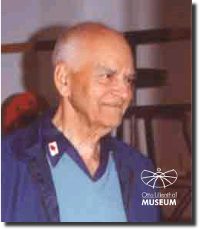 March 20, 1951
March 20, 1951- Patent
for flexible wings: In 1948, the NASA-engineer Francis Melvin Rogallo
applies for a patent for a different delta-airfoil. It was tested by
NASA as a landing system for space modules until the Gemini Program.
The System is the next decisive step in development from Lilienthal's
gliders to today's hang gliding (presented in the exhibition).
- October 4, 1957
- Sputnik-I the first man-made satellite launched into
orbit, reaching a height of 800 km. Sputnik-2 with the dog Laika on
board, is launched on the 3rd of November. Laika did not survive.
- April 12, 1961
- Yuri Gagarin (Soviet Union) becomes the first human
in space in the "Wostock-1".
- 1963
- John
Dickenson/Australia used an A-Frame for the control of a Hang glider.
- January 3-24, 1963
- Sailing flight world championship in Argentina: The
discipline "free route" will not be held in the future because the
performances are too lengthy (distance reached by the winner: 716 km).
- March 2, 1969
- First flight of the first supersonic airliner
"Concord"
- July 20, 1969
- The astronauts Armstrong and Aldrin (USA) are the
first humans who set foot on another celestial body - the moon.
- November 18, 1971
- The Soviet lunar module "Lunochod" lands on the earth
satellite.
- April 11, 1973
- The American Mike Harker flew with a hang glider from
the south face of the Zugspitze, which measures 2,000 m in height down
into the valley. This sensational flight with this new aviation device
made a breakthrough in Europe.
- September 1-12, 1976
- First world championship for hang gliding in
Kössen/Tyrol.
- August 12-18, 1978
- The Americans Abruzzo, Anderson and Newman cross the
Atlantic in a Montgolfière (USA-France).
- June 12, 1979
- The muscle-powered aircraft "Gossamer Albatross"
crosses the English Channel (36 km in 2 h, 49 min).
- 1979
- German
Test Pilot Hanna Reitsch's last record flight was an 800 km glider
round trip from Pennsylvania down the Appalachian mountains. She died
of a heart attack a few months later at 67 years old.
- 1980
- Engineless hang glider flight in the Sierra Nevada
Mountains (USA), soaring to over 5,180 meters and traveling more than
160 km by George Worthington.
- April 12, 1981
- A new technology combines aviation with astronautics.
The space shuttle "Columbia" starts at Cape Canaveral.
- February 7, 1984
- The
US-Astronaut Bruce McCandless floats free in space. Gas jets attached
to his backpack allow him to do maneuvers within a radius of 100 meters
and to return to the space shuttle "Challenger".
- December 23, 1986
- Flying around the world non-stop and without
refueling was the last
record to break. The American pilots, Dick Rutan and Jenna Yeager
complete the flight in their 3-bodied experimental, composite airplane,
"Voyager." (On display in the entrance of the National Air and Space
Museum Washington, DC) After the nine day flight and covering 40,000
km, they landed at their starting point at Edwards Air Force Base in
California. The "U.S. News & World Report" writes about "the
last
great adventure in aviation"!
- April 23, 1988
- New world record in muscle-powered flight on the
traces of a legend: The Greek professional cyclist K. Kanellopouios
flies with a muscle-powered aircraft designed by the Massachusetts
Institute of Technology "Daedalus 88", which weighs 32 kg, 119 km from
Crete to the Aegean island Santorini.
- March 1-21, 1999
- Again a "last adventure of aviation": The Swiss
Bertrand Picard and the Englishman Brian Jones fly successfully fly
around the world in a balloon without propulsion, in a so-called
Roziere (Combination of a helium- and a hot-air balloon). The key to
their success was the "jet-stream", air current over 10,000 meters high
with speeds up to 300 km/h.
- August 13, 2001
- Flight on the edge atmosphere: The unmanned NASA
solar airplane Helios flew a
height world record of 29.413 m. 14 electric motors and a wing span of
75.3 metres allowed this flight.
- September 11, 2001
- Using
four hijacked commercial airliners, nineteen suicide bombers
coordinated an attack on symbolic buildings in New York and Washington,
D.C. that resulted in over 3,000 fatalities. Again, aviation is used as
a means for a cause, a symbol, or justification for an event that
changed the way of life and military strategies in every country on
Earth.
- June 18 to July 2, 2002
- American Steve Fossett flew alone around the world in
a hot air balloon. The balloon named "Bud Light Spirit of Freedom"
carried a 2,1 * 1,7 m nacelle.
- April, 2011
- The company Festo presented at the Hanover Fair the Smartbird, a fully controllable artificial bird with wings drive. With two-meter wingspan and a weight of 0.45 kg, it requires a power of 23 watts.
- March 2015 to July 2016
- Circumnavigation of the Solar Impuls 2, the first solar powered aircraft. The flight of the Swiss Bertrand Piccard and André Borschberg led in 17 stages from Abu Dhabi over China, Japan, the USA, Spain and Egypt back to Abu Dhabi, with a more than 9-month repair break in Hawaii.
-
 About 2300
BC
About 2300
BC 2nd
Century BC - 5th Century AD
2nd
Century BC - 5th Century AD 1670
AD
1670
AD  1784
1784 September
24, 1852
September
24, 1852 1871
1871  1883/84
1883/84  1895
to 1899
1895
to 1899 July
17, 1920
July
17, 1920 March 20, 1951
March 20, 1951